Montreux Oberland Bernois Railway
The Montreux Oberland Bernois Railway (French: Chemin de fer Montreux Oberland Bernois, German: Montreux Berner Oberland Bahn, abbreviated MOB), is a railway operating in southwest Switzerland, one of the oldest electric railways in the country; its main line, 62.4 km (38.8 mi) in length, built to 1,000 mm (3 ft 3 3⁄8 in) gauge, connects Montreux, Gstaad, and Zweisimmen, where passengers can transfer to the BLS AG owned, and standard gauge, Zweisimmen to Spiez line. There is also a 12.9 km (8.0 mi) branch-line from Zweisimmen to Lenk.
| Montreux Oberland Bernois Railway | |||||||||||||||||||||||||||||||||||||||||||||||||||||||||||||||||||||||||||||||||||||||||||||||||||||||||||||||||||||||||||||||||||||||||||||||||||||||||||||||||||||||||||||||||||||||||||||||||||||||||||||||||||||||||||||||||||||||||||||||||||||||||||||||||||||||||||||||||||||||||||||||||||||||||||||||||||||||||||||||||||||||||||||||||||||||||||||||||||||||||||||||||||||||||||||||||||||||||||||||||||||||||||||||||||||||||||||||||||||||||||||||||||||||||||||||||||||||||||||||||||||||||||||||||||||||||||||||||||||||||||||||||||||||||||||||||||||||||||||||||||||||||||||||||||||||||||||||||||||||||||||||||||||||||
|---|---|---|---|---|---|---|---|---|---|---|---|---|---|---|---|---|---|---|---|---|---|---|---|---|---|---|---|---|---|---|---|---|---|---|---|---|---|---|---|---|---|---|---|---|---|---|---|---|---|---|---|---|---|---|---|---|---|---|---|---|---|---|---|---|---|---|---|---|---|---|---|---|---|---|---|---|---|---|---|---|---|---|---|---|---|---|---|---|---|---|---|---|---|---|---|---|---|---|---|---|---|---|---|---|---|---|---|---|---|---|---|---|---|---|---|---|---|---|---|---|---|---|---|---|---|---|---|---|---|---|---|---|---|---|---|---|---|---|---|---|---|---|---|---|---|---|---|---|---|---|---|---|---|---|---|---|---|---|---|---|---|---|---|---|---|---|---|---|---|---|---|---|---|---|---|---|---|---|---|---|---|---|---|---|---|---|---|---|---|---|---|---|---|---|---|---|---|---|---|---|---|---|---|---|---|---|---|---|---|---|---|---|---|---|---|---|---|---|---|---|---|---|---|---|---|---|---|---|---|---|---|---|---|---|---|---|---|---|---|---|---|---|---|---|---|---|---|---|---|---|---|---|---|---|---|---|---|---|---|---|---|---|---|---|---|---|---|---|---|---|---|---|---|---|---|---|---|---|---|---|---|---|---|---|---|---|---|---|---|---|---|---|---|---|---|---|---|---|---|---|---|---|---|---|---|---|---|---|---|---|---|---|---|---|---|---|---|---|---|---|---|---|---|---|---|---|---|---|---|---|---|---|---|---|---|---|---|---|---|---|---|---|---|---|---|---|---|---|---|---|---|---|---|---|---|---|---|---|---|---|---|---|---|---|---|---|---|---|---|---|---|---|---|---|---|---|---|---|---|---|---|---|---|---|---|---|---|---|---|---|---|---|---|---|---|---|---|---|---|---|---|---|---|---|---|---|---|---|---|---|---|---|---|---|---|---|---|---|---|---|---|---|---|---|---|---|---|---|---|---|---|---|---|---|---|---|---|---|---|---|---|---|---|---|---|---|---|---|---|---|---|---|---|---|---|---|---|---|---|---|---|---|---|---|---|---|---|---|---|---|---|---|---|---|---|---|---|---|---|---|---|---|---|---|---|---|---|---|---|---|---|---|---|---|---|---|---|---|---|---|---|---|---|---|---|---|---|---|---|---|---|---|---|---|---|---|---|---|---|---|---|---|---|---|---|---|---|---|---|---|---|---|---|---|---|---|---|---|---|---|---|---|---|---|---|---|---|---|---|---|---|---|---|---|---|---|---|---|---|---|---|---|---|---|---|---|---|---|---|---|---|---|---|---|---|---|---|---|---|---|---|---|---|---|---|---|---|---|---|---|---|---|---|---|---|---|---|---|---|---|---|---|---|---|---|---|---|---|---|---|---|---|---|---|---|---|---|
 | |||||||||||||||||||||||||||||||||||||||||||||||||||||||||||||||||||||||||||||||||||||||||||||||||||||||||||||||||||||||||||||||||||||||||||||||||||||||||||||||||||||||||||||||||||||||||||||||||||||||||||||||||||||||||||||||||||||||||||||||||||||||||||||||||||||||||||||||||||||||||||||||||||||||||||||||||||||||||||||||||||||||||||||||||||||||||||||||||||||||||||||||||||||||||||||||||||||||||||||||||||||||||||||||||||||||||||||||||||||||||||||||||||||||||||||||||||||||||||||||||||||||||||||||||||||||||||||||||||||||||||||||||||||||||||||||||||||||||||||||||||||||||||||||||||||||||||||||||||||||||||||||||||||||||
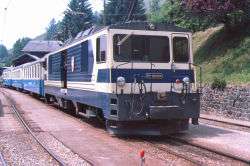 MOB train at Les Avants on 11 July 1985. | |||||||||||||||||||||||||||||||||||||||||||||||||||||||||||||||||||||||||||||||||||||||||||||||||||||||||||||||||||||||||||||||||||||||||||||||||||||||||||||||||||||||||||||||||||||||||||||||||||||||||||||||||||||||||||||||||||||||||||||||||||||||||||||||||||||||||||||||||||||||||||||||||||||||||||||||||||||||||||||||||||||||||||||||||||||||||||||||||||||||||||||||||||||||||||||||||||||||||||||||||||||||||||||||||||||||||||||||||||||||||||||||||||||||||||||||||||||||||||||||||||||||||||||||||||||||||||||||||||||||||||||||||||||||||||||||||||||||||||||||||||||||||||||||||||||||||||||||||||||||||||||||||||||||||
| Overview | |||||||||||||||||||||||||||||||||||||||||||||||||||||||||||||||||||||||||||||||||||||||||||||||||||||||||||||||||||||||||||||||||||||||||||||||||||||||||||||||||||||||||||||||||||||||||||||||||||||||||||||||||||||||||||||||||||||||||||||||||||||||||||||||||||||||||||||||||||||||||||||||||||||||||||||||||||||||||||||||||||||||||||||||||||||||||||||||||||||||||||||||||||||||||||||||||||||||||||||||||||||||||||||||||||||||||||||||||||||||||||||||||||||||||||||||||||||||||||||||||||||||||||||||||||||||||||||||||||||||||||||||||||||||||||||||||||||||||||||||||||||||||||||||||||||||||||||||||||||||||||||||||||||||||
| Native name | Chemin du fer Montreux Oberland Bernois | ||||||||||||||||||||||||||||||||||||||||||||||||||||||||||||||||||||||||||||||||||||||||||||||||||||||||||||||||||||||||||||||||||||||||||||||||||||||||||||||||||||||||||||||||||||||||||||||||||||||||||||||||||||||||||||||||||||||||||||||||||||||||||||||||||||||||||||||||||||||||||||||||||||||||||||||||||||||||||||||||||||||||||||||||||||||||||||||||||||||||||||||||||||||||||||||||||||||||||||||||||||||||||||||||||||||||||||||||||||||||||||||||||||||||||||||||||||||||||||||||||||||||||||||||||||||||||||||||||||||||||||||||||||||||||||||||||||||||||||||||||||||||||||||||||||||||||||||||||||||||||||||||||||||||
| Technical | |||||||||||||||||||||||||||||||||||||||||||||||||||||||||||||||||||||||||||||||||||||||||||||||||||||||||||||||||||||||||||||||||||||||||||||||||||||||||||||||||||||||||||||||||||||||||||||||||||||||||||||||||||||||||||||||||||||||||||||||||||||||||||||||||||||||||||||||||||||||||||||||||||||||||||||||||||||||||||||||||||||||||||||||||||||||||||||||||||||||||||||||||||||||||||||||||||||||||||||||||||||||||||||||||||||||||||||||||||||||||||||||||||||||||||||||||||||||||||||||||||||||||||||||||||||||||||||||||||||||||||||||||||||||||||||||||||||||||||||||||||||||||||||||||||||||||||||||||||||||||||||||||||||||||
| Track gauge | 1,000 mm (3 ft 3 3⁄8 in) metre gauge | ||||||||||||||||||||||||||||||||||||||||||||||||||||||||||||||||||||||||||||||||||||||||||||||||||||||||||||||||||||||||||||||||||||||||||||||||||||||||||||||||||||||||||||||||||||||||||||||||||||||||||||||||||||||||||||||||||||||||||||||||||||||||||||||||||||||||||||||||||||||||||||||||||||||||||||||||||||||||||||||||||||||||||||||||||||||||||||||||||||||||||||||||||||||||||||||||||||||||||||||||||||||||||||||||||||||||||||||||||||||||||||||||||||||||||||||||||||||||||||||||||||||||||||||||||||||||||||||||||||||||||||||||||||||||||||||||||||||||||||||||||||||||||||||||||||||||||||||||||||||||||||||||||||||||
| Electrification | 850 V DC Overhead line | ||||||||||||||||||||||||||||||||||||||||||||||||||||||||||||||||||||||||||||||||||||||||||||||||||||||||||||||||||||||||||||||||||||||||||||||||||||||||||||||||||||||||||||||||||||||||||||||||||||||||||||||||||||||||||||||||||||||||||||||||||||||||||||||||||||||||||||||||||||||||||||||||||||||||||||||||||||||||||||||||||||||||||||||||||||||||||||||||||||||||||||||||||||||||||||||||||||||||||||||||||||||||||||||||||||||||||||||||||||||||||||||||||||||||||||||||||||||||||||||||||||||||||||||||||||||||||||||||||||||||||||||||||||||||||||||||||||||||||||||||||||||||||||||||||||||||||||||||||||||||||||||||||||||||
| Highest elevation | 1,269 m (4,163 ft) | ||||||||||||||||||||||||||||||||||||||||||||||||||||||||||||||||||||||||||||||||||||||||||||||||||||||||||||||||||||||||||||||||||||||||||||||||||||||||||||||||||||||||||||||||||||||||||||||||||||||||||||||||||||||||||||||||||||||||||||||||||||||||||||||||||||||||||||||||||||||||||||||||||||||||||||||||||||||||||||||||||||||||||||||||||||||||||||||||||||||||||||||||||||||||||||||||||||||||||||||||||||||||||||||||||||||||||||||||||||||||||||||||||||||||||||||||||||||||||||||||||||||||||||||||||||||||||||||||||||||||||||||||||||||||||||||||||||||||||||||||||||||||||||||||||||||||||||||||||||||||||||||||||||||||
| Maximum incline | 7.3% | ||||||||||||||||||||||||||||||||||||||||||||||||||||||||||||||||||||||||||||||||||||||||||||||||||||||||||||||||||||||||||||||||||||||||||||||||||||||||||||||||||||||||||||||||||||||||||||||||||||||||||||||||||||||||||||||||||||||||||||||||||||||||||||||||||||||||||||||||||||||||||||||||||||||||||||||||||||||||||||||||||||||||||||||||||||||||||||||||||||||||||||||||||||||||||||||||||||||||||||||||||||||||||||||||||||||||||||||||||||||||||||||||||||||||||||||||||||||||||||||||||||||||||||||||||||||||||||||||||||||||||||||||||||||||||||||||||||||||||||||||||||||||||||||||||||||||||||||||||||||||||||||||||||||||
| Rack system | None | ||||||||||||||||||||||||||||||||||||||||||||||||||||||||||||||||||||||||||||||||||||||||||||||||||||||||||||||||||||||||||||||||||||||||||||||||||||||||||||||||||||||||||||||||||||||||||||||||||||||||||||||||||||||||||||||||||||||||||||||||||||||||||||||||||||||||||||||||||||||||||||||||||||||||||||||||||||||||||||||||||||||||||||||||||||||||||||||||||||||||||||||||||||||||||||||||||||||||||||||||||||||||||||||||||||||||||||||||||||||||||||||||||||||||||||||||||||||||||||||||||||||||||||||||||||||||||||||||||||||||||||||||||||||||||||||||||||||||||||||||||||||||||||||||||||||||||||||||||||||||||||||||||||||||
| |||||||||||||||||||||||||||||||||||||||||||||||||||||||||||||||||||||||||||||||||||||||||||||||||||||||||||||||||||||||||||||||||||||||||||||||||||||||||||||||||||||||||||||||||||||||||||||||||||||||||||||||||||||||||||||||||||||||||||||||||||||||||||||||||||||||||||||||||||||||||||||||||||||||||||||||||||||||||||||||||||||||||||||||||||||||||||||||||||||||||||||||||||||||||||||||||||||||||||||||||||||||||||||||||||||||||||||||||||||||||||||||||||||||||||||||||||||||||||||||||||||||||||||||||||||||||||||||||||||||||||||||||||||||||||||||||||||||||||||||||||||||||||||||||||||||||||||||||||||||||||||||||||||||||
History and route
The main line of the MOB was opened in stages, the first, from Montreux to Les Avants (10.9 km or 6.8 mi) on 17 December 1901, followed by the Les Avants to Montbovon (11.2 km or 7.0 mi) section on 1 October 1903. The next stages from Montbovon to Château-d'Œx (10.6 km or 6.6 mi) and then Gstaad (13.1 km or 8.1 mi) followed on 19 August 1904 and 20 December 1904 respectively, the final 16.6 km (10.3 mi) of the line reaching Zweisimmen on 6 July 1905. The spur line to Lenk was opened in 1912.
From the very start, the MOB had the character of a mainline railway and, at an early stage, through trains with dining and saloon coaches were introduced. The creation of the Golden Mountain Pullman Express in 1931 was unfortunately at a time of world economic crisis and this accounted for its lack of success. The saloon coaches 103–106 built for this train by Compagnie Internationale des Wagons-Lits (CIWL) were sold to the Rhaetian Railway in 1939, where they are still in use (As 1141–44). Two of the original (1913–14 built) coaches have been restored by the MOB and are used for "Chocolate train" services in the summer months, but still regularly find work on the main line "Classic train" services on Sundays throughout the year. The modern successor of this luxury train is the Golden Pass Panoramic Express, which for the past few years has aroused growing enthusiasm.
The MOB begins its journey in Montreux, departing trains normally making use of platform 5 and arrivals platform 6, between the Swiss Federal Railway platforms and those of the rack and pinion railway to the Rochers de Naye. Winding its way up through the vineyards above Lake Geneva via Chamby, as far as Les Avants, the line passes through the crown tunnel under the Col de Jaman to reach the Saane Valley. In Montbovon there is a connection to the Transports Publics Fribourgeois (TPF; previously GFM) network. Following the Saane upstream, passing the famous hot-air ballooning centre of Château-d'Oex, it leaves the French-speaking canton of Vaud near Rougemont and enters the German-speaking canton of Berne. After Saanen the planners would have liked a direct ascent of the Sannenmöser Pass but without the aid of a rack and pinion system this was impossible and the line was diverted to loop around the village of Gstaad, adding greatly to the development and prosperity of the community. Beyond Gstaad railway station it begins the climb to the head of Saanenmöser Pass, the highest point on the line at 1270 m (3937 ft). On the other side it descends the Simmen Valley to Zweisimmen, where there is a connection to the standard gauge line of the BLS to Spiez.
Over the years, while passenger traffic boomed, freight traffic diminished with 2006 seeing the end of cement transport between Montreux and Saanen and the transport of standard gauge wagons on transporter bogies between Zweisimmen and stations to Rougemont and Lenk. By the end of the year the MOB was a passenger only operation, however in Spring 2007 the company purchased nine gravel (hopper) wagons and two surplus locomotives from the TPF. The MOB now operates this transport from Grandvillard (on the TPF line) to Saanen.
The Lenk branch retraces this route for a very short distance before continuing on its own trackbed. Because of its poor state of repair, this line was closed on 14 June 1975, however, it was fully modernized between 1977 and 1979, having new tracks and overhead lines, reopening on 27 September 1979. New rolling stock was purchased (* in the list below) to operate this line together with the weekdays school service between Zweisimmen and Saanen. Since reopening it has been included in the regular operating schedule of the MOB with timetabled connections to the main line services. To celebrate the centenary of the opening of the Lenk line (June 2012), the MOB arranged a week of festivities with a dinner, special fares and operation and display of rolling stock usually to be found on museum lines, particularly that at Blonay-Chamby.
- (Source: Journal du Pays d'Enhaut, published 24 May 2012)
Modernisation program
In Spring 2008 the MOB announced a four-year plan to modernise the railway infrastructure and rebuild stations to bring them all into the 21st century. This programme began with the demolition of little used facilities; the goods shed in Gstaad and the shed in Château-d'Œx, this latter structure being replaced by a free-standing shelter, for example. During 2008 much work took place on the overhead line equipment with replacement supports being positioned along the line although not brought into use they stand ready for the new wiring. It is expected that this work will continue, up to 4 nights per week through to December 2009, subject to weather conditions. New deeper ballasting has taken place along many sections of the line and this will be continued until the line has all been done.
The work at Gstaad consisted of a complete rebuilding of the platforms to full height and simplification of the track layout. After almost 100 years the station got platform canopies and passenger operated lifts linked by a pedestrian underpass. During this rebuilding the station was reduced to a single line. The canopy is of wooden construction supported on metal uprights. The new layout gives the original platform as No.1 with the new island platform being Nos. 2 and 3. This work was officially opened, if not fully finished, on 13 June 2009.
At Saanenmöser station a straightforward relaying and alignment took place through late 2008 / early 2009 which maintained the passing and siding facility at that location.
During the early part of 2010, by the end of May, the stations underwent a rebranding along with those of other lines which come under the "Golden Pass" banner. All were fitted with signs bearing the new "Golden Pass" logo and name alongside the station nameboards, which were retained in their original colours.
One of the smallest stations / halts, Les Combes, between Château-d'Œx and Rougemont, was given a new, raised platform during Autumn 2011 leaving only the waiting shelter as original, quite a lot of money spent for so few passengers.
Work commenced on the rebuilding of Château-d'Œx station in mid - September 2013 and plans were published in the local newspaper with details of the work which is carried out in three phases and completed by the end of 2014. Throughout the work the passing loop facility was maintained and raised platforms constructed reached by subways from the station front. Construction work was delayed and the station officially reopened on 28 November 2015.
- (Source : 24 heures, Vaud edition, various dates in April/May 2009)
- (Source : Journal du Pays d'Enhaut, 1 October 2009)
- (Source : Journal du Pays d'Enhaut, 12 September 2013)
- (Source : Journal du Pays d'Enhaut, 26 November 2015)
Timetables and train formations
From the beginning of 2011 timetable there are two Golden Pass Panoramic services, with VIP seating (domed end cars), departing Montreux at 09h45 (Train 3118) and 15h45,(Train Nos 2128), the Lenk branch ceases to be served, the "through" working only lasting one year (2010). It is normally made up in the following formation and operate in the "push–pull" mode :
- Ast / Brs / As / Locomotive / BDs / Bs* / Arst* : This is the length limit of the train due to platform lengths. Trains may be shorter off-season.
In the reverse direction the Golden Pass trains with VIP (domed observation cars) seating are the 12h26 (Train 2119) and 18h20 from Zweisimmen (Train 2131).
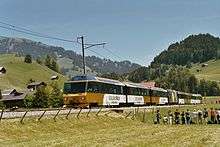 Golden Pass Panoramic passing near Rougemont during centennial celebration on 29 May 2004 |
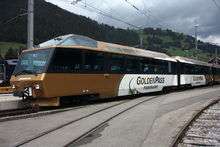 Ast 116 and Brs 228 at the head of a Montreux-bound train in Zweisimmen on 23 June 2004 |
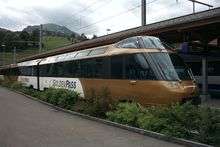 Arst 152 at the end of the same train |
 Original Crystal Panoramic livery of Arst 151–152 and As 153–154, now Bs 251–252. Zweisimmen, 17 July 1993 |
There are other Golden Pass trains without VIP seating (dome end cars) and these depart Montreux at 07h45, 11h49, 14h47 and 17h45 (Trains 2112, 2124, 2228 and 2134) and from Zweisimmen at 08h26, 10h26, 14h26 and 17h05 (Trains 2111, 3115, 3123 and 2229). These trains are locomotive hauled and use stock not required for the trains with VIP seating. The formation, which is flexible, is usually as follows :
- Locomotive / As / As / BDs / Bs / Bs
This leaves a surplus of one domed observation car (two in use on the Golden Pass panorama and one on the "Chocolate Train")
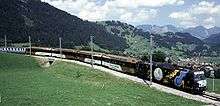 Golden Pass Panoramic with a blue/cream coach replacing a panoramic coach, 27 July 2006 above Zweisimmen |
 The very first panoramic coach, As 110 of 1976, still in its original livery which it maintained until May 2008 photographed on 25 June 2004 in Zweisimmen |
Golden Pass Classic trains operate daily departing Montreux at 08h47 and 13h45 (Trains 2216 and 3126), returning from Zweisimmen at 11h09 and 16h26 (Trains 2217 and 2127) and are made up in the following formation :
- Locomotive / As / As / Brs / Bs / Non-Classic Type BD (to provide cycle / luggage space)
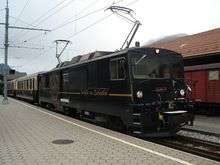 MOB GDe 4/4 6002 with Golden Pass Classic in Zweisimmen, 2005-05-06 |
 MOB As 107 and 103 after arrival of the Golden Pass Classic in Montreux |
 Detail of GDe 4/4 6002 |
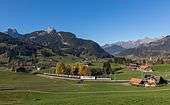 GDe 4/4 6004 hauls a Golden Pass Classic, between Gstaad and Gruben |
The Golden Pass "Chocolate Train" operates in June, September and October every Monday, Wednesday and Friday and in July and August Monday to Friday, departing Montreux at 09h12 (Train 2118) but no return working is shown in the timetable. Until the end of the 2008 season it was made up in the following formation which ran throughout between Montreux and Broc Fabrique:
- Locomotive / Belle Epoque Ars / Belle Epoque As / Other vehicles as required (usually Panorama type and/or Non-Classic type BD).
In the 2009 timetable the formation was changed and only operated between Montreux and Gruyere only with a coach connection to Broc (Due to operating problems), as follows:
- Locomotive (Usually 6003 Saanen, in special Chocolate Train livery) / Belle Epoque Ars / Belle Epoque Ars / Golden Pass Panorama observation car (No. 116 or 117) operating in "Push – Pull" mode.
Other trains Montreux–Zweisimmen may be pulled by a Ge 4/4, GDe 4/4 or an ABDe 8/8 and they can have up to five coaches.
Local services operate connecting Montreux to Fontanivent (Mon – Fri ), Chernex, Sonzier and Les Avants, operated by Be 2/6 7001–7004 and from Château-d'Oex, Saanen or Gstaad to Zweisimmen. The branch-line from Zweisimmen to Lenk offers a regular service timetabled to connect into and out of the MOB main line services. These trains are operated by Be 4/4 5001–5004.
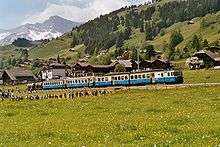 Regional train with ABDe 8/8 4004, AB 304, one B and two Ucek on 29 May 2004 |
 Local service with ABt 343 – Be 4/4 5003 – Bt 243 on 29 May 2004 near Rougemont |
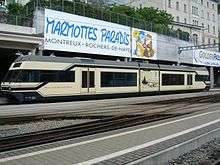 MVR Be 2/6 7004 in Montreux local service on 6 May 2005 |
Locomotives and motor coaches
For decades the traffic on the MOB was handled by electric motor coaches available in four-, six- and eight-axle designs. In 1983, four locomotives of the type GDe 4/4 were bought, to be followed in 1994 by four newer and more powerful Ge 4/4 locomotives from the same manufacturer. These are similar to the ones purchased by the RhB and BAM. Any of these locomotives can be seen working the principal trains.
In December 2006, the TPF relinquished its freight operations to the SBB Cargo, and its two GDe 4/4 locomotives became surplus to requirements. In April 2007, these were purchased by the MOB and have since been allocated numbers following on from those of their new owners.
The MOB is run with 900 V DC overhead contact and has gradients of up to 7.3% (1 in 13.5).
| No. | Name | Class | Builders | Works No./Date Built | Notes. |
|---|---|---|---|---|---|
| 3 | Tm 2/2 | KHD | 55736-1955 | Ex- V22, Euskirchener Kreisbahnen, Germany: Sold 1966 to VGH (Germany) V121. | |
| 4 | Tm 2/2 | 1934 | Ex-Rhätische Bahn 9913 | ||
| 5 | Béa | Tm 2/2 | Kaelble-Gmeinder | 5553-1976 | 2007 ex-Benkler 25 |
| 6 | Elsbeth | Tm 2/2 | Kaelble-Gmeinder | 5586-1980 | 2007 ex-Benkler 26 |
| 7 | Tm 2/2 | 1950 | Ex-Rhätische Bahn 9914 | ||
| 28 | De 4/4 | SIG/BBC | 1924 | Engineers Dept. Out of use, Fontaviant (8.13) | |
| 1001 | Montreux | Be 4/4 | ACMV/SWS/MFO/BBC | 1955 | Ex-Lugano–Cadro–Dino railway. Sold to MOB and rebuilt 1973. Repainted in Black/White locomotive livery with small "MOB Golden Pass" in black (on white) in Autumn 2015, Nameplates removed. |
| 1002 | Saanen | Be 4/4 | SWS/SAAS | 1951 | Ex-Biasca–Acquarossa railway 4, reserve in Zweisimmen |
| 1003 | Be 4/4 | SWS/SAAS | 1958 | Ex-Lugano–Ponte Tresa railway 5. Brought by MOB 1981, reserve in Saanen (July 2009) | |
| 1006 | Be4/4 | R+J | 1997 | Seen in Chernex, June 2013 sporting orange/grey livery. | |
| 1007 | Be4/4 | R+J | 1997 | Seen in Montreux, June 2013 sporting orange/grey livery. | |
| 2003 | Montbovon | Gm 4/4 | Moyse/CFD*/Poyaud | 1976 | Spring 2009 to Chernex works. |
| 2004 | Albeuve | Gm 4/4 | Moyse/CFD*/Poyaud | 1982 | *Ateliers de Montmirail, Chassis No. BB825 |
| 3001 | Rougemont | BDe 4/4 | SIG/BBC | 1944 | Ex-2nd/Brake,now Engineers Dept. use. Retained blue/cream livery until scrapped in December 2009. |
| 3002 | Château-d'Œx | BDe 4/4 | SIG/BBC | 1944 | Ex-2nd/Brake,At 7.2009 being stripped out, Chernex Works. Moved to Vevey for asbestos removal and at 6.2010 awaits further attention at Chernex. |
| 3004 | BDe 4/4 | SIG/BBC | 1944 | Ex-2nd/Brake,now Engineers Dept. use, all over dark blue livery (2006), repainted Vevey, 2009. | |
| 3005 | BDe 4/4 | SIG/BBC | 1946 | Ex-2nd/Brake,now Engineers Dept. use, all over dark blue livery. | |
| 3006 | BDe 4/4 | SIG/BBC | 1946 | Ex-2nd/Brake,now Engineers Dept. use, all over dark blue livery. | |
| 4001 | Suisse | ABDe 8/8 | SIG/BBC/SAAS | 1968 | |
| 4002 | Vaud | ABDe 8/8 | SIG/BBC/SAAS | 1968 | |
| 4003 | Bern | ABDe 8/8 | SIG/BBC/SAAS | 1968 | |
| 4004 | Fribourg | ABDe 8/8 | SIG/BBC/SAAS | 1968 | |
| *5001 | Be 4/4 | SIG/SAAS | 1976 | Note 1. Rebuilt Raility/MOB Chernex, left works 7 July 2009 - Originally named "Montreux" before rebuild. | |
| *5002 | Be 4/4 | SIG/SAAS | 1976 | Note 1. Rebuilt Raility/MOB Chernex, left works 20 August 2008 - Originally named "Zweisimmen" before rebuild. | |
| *5003 | Be 4/4 | SIG/SAAS | 1976 | Note 1. Rebuilt R+J/MOB Chernex, 2004 - Originally named "Lenk" before rebuild. | |
| *5004 | Be 4/4 | SIG/SAAS | 1976 | Note 1. Rebuilt R+J/MOB Chernex, 200. - Originally named "St Stephan" before rebuild. | |
| 6001 | Vevey | GDe 4/4 | SLM/BBC | 1983 | |
| 6002 | Isabelle von Siebenthal | GDe 4/4 | SLM/BBC | 1983 | Originally named "Rossiniere" |
| 6003 | Saanen | GDe 4/4 | SLM/BBC | 1983 | In 1983 this locomotive broke the record for Swiss narrow gauge trains with a speed of 110 km/h. From April 2009 in "Chocolate Train" livery. |
| 6004 | Interlaken | GDe 4/4 | SLM/BBC | 1983 | |
| 6005 | GDe 4/4 | SLM/BBC | 1983 | Ex-TPF (GFM) No.101 Ville de Bulle, Sold to MOB April 2007, Name removed March 2008. Repainted in "Golden Pass" livery, May 2011. | |
| 6006 | GDe 4/4 | SLM/BBC | 1983 | Ex-TPF (GFM) No.102 Neirivue, Sold to MOB April 2007, Name removed June 2009. From Summer 2015 carries livery of Badoux Vins with the sides showing their most popular brand of red wine. | |
| 8001 | Ge 4/4 | SLM/ABB | 1994 | Livery: Gstaad Mountain Rides. | |
| 8002 | Ge 4/4 | SLM/ABB | 1994 | Livery: Golden Pass Line livery. | |
| 8003 | Ge 4/4 | SLM/ABB | 1994 | Livery: Menuhin Festival Gstaad. | |
| 8004 | Ge 4/4 | SLM/ABB | 1994 | Livery: Golden Pass Line livery. | |
| 9201 | Be4/4 | Stadler/ABB | 1.2.2016 | Livery: Midnight Blue / White. Note 3 | |
| 9301 | ABe4/4 | Stadler/ABB | 1.2.2016 | Livery: Midnight Blue / White. Note 3 | |
| 9202 | Be4/4 | Stadler/ABB | 9.3.2016 | Livery: Midnight Blue / White. Note 3 | |
| 9302 | ABe4/4 | Stadler/ABB | 9.3.2016 | Livery: Midnight Blue / White. Note 3 | |
| 9203 | Be4/4 | Stadler/ABB | 9.3.2016 | Livery: Midnight Blue / White. Note 3 | |
| 9303 | ABe4/4 | Stadler/ABB | 9.3.2016 | Livery: Midnight Blue / White. Note 3 | |
| 9204 | Be4/4 | Stadler/ABB | 7.6.2016 | Livery: Midnight Blue / White. Note 3 | |
| 9304 | ABe4/4 | Stadler/ABB | 7.6.2016 | Livery: Midnight Blue / White. Note 3 | |
Withdrawn and Preserved Items
| No. | Name | Class | Builders details | Date Built | Notes. |
|---|---|---|---|---|---|
| 1 | Tm 2/2 | O&K, Berlin | 1930 | Chemin de fer-musee Blonay-Chamby, 2006. | |
| 2 | Heinrich II | Tm 2/2 | KHD | 1953 | Ex-Juist Island (Germany); to Chemin de Fer de la Somme. |
| 11 | BCFe 4/4 | SIG/Alioth | 1905 | Chemin de fer-musee Blonay-Chamby, 1999. | |
| 26 | BFZe 4/4 | SIG/Alioth | 1914 | 1995 to Modellbahngruppe Obersimmental-Sannenland, stabled on line at Saanen. Repainted blue/cream livery, May 2008 | |
| 27 | De 4/4 | SIG/BBC | 1924 | Engineers Dept., scrapped July 2002 | |
| 36 | BDe 4/4 | SIG/SWS/VBW/MFO | 1913 | Rebuilt 1951, 2007 handed over to association "Ds Blaue Bähnli" who plan to return it to Bern – Worb. | |
| 37 | BDe 4/4 | SIG/SWS/VBW/MFO | 1913 | Rebuilt 1958, scrapped July 2000 | |
| 61 | B4 | SIG | 1906 | Pre-1956 Second Class saloon coach, 1979 to Modellbahngruppe Obersimmental-Sannenland, stabled on line at Saanen. Repainted blue/cream livery, May 2008 | |
| 529 | K (Gk) | Busch, Bautzen | 1905 | 1995 to Modellbahngruppe Obersimmental-Sannenland, stabled on line at Saanen. | |
| 1004 | Scrapped 1996 | ||||
| 1005 | Scrapped 1996 | ||||
| 1006 | SWS/SAAS | Preserved at VBW | |||
| 2002 | DZe 6/6 | SIG/BBC | 1932 | Works No.3702., to Blonay-Chamby 2008 | |
| 3003 | BDe 4/4 | SIG/BBC | Scrapped 1996 | ||
| 3004 | Be 4/4 | SWS/SAAS | 1944 | Built and painted special livery for the Super Panorama Express. | |

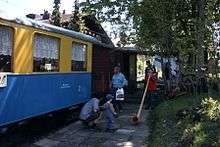
Note 1: Class Be 4/4 after rebuild operate as the centre-car (non driving motor) of a three-car set made up as Bt – BDe4/4 – ABt. The Bt vehicles are numbered 241 – 244 and the ABt vehicles 341 – 344. Bt242 carries R+J Builders plate 70671 – 2005.
Note 2: Class Be 2/6, No's 7001 to 7004, are listed under the stock owned by the Chemins de fer électriques Veveysans (CEV) but they also work short journeys over the MOB from Montreux to Fontanivent, Sonzier and Les Avents.
Note 3: These units operate in pairs [ie xx02 + xx03] with coaches between-
Abbreviations
- ABB/BBC Asea-Brown-Boveri AG / Brown, Boveri & Cie
- ACMV Ateliers de constructions mécaniques de Vevey
- O&K Orenstein & Koppel
- R+J Ramseier and Jenzer, Biel.
- SAAS Société Anonyme des Ateliers de Sécheron, Geneva.
- SLM Swiss Locomotive and Machine Works, Winterthur
- SIG Schweizerische Industriegesellschaft, Neuhausen am Rheinfall
- SWS Schweizerische Wagons- und Aufzügefabrik, Schlieren ZH
Livery
In 2009 a decision was made to change the livery on all rolling stock except for the Golden Pass Panorama and Golden Pass Classic trains. This was to include the various railways and funiculars marketed under the "Golden Pass" banner and the buses operated by the company. The colour scheme is to be a gold (lower portion) and white (upper portion) with all stock being rebranded "Golden Pass". The new colours will be applied to the stock as it passes through works, although the "Golden Pass" logo will be applied as soon as practicable. The first vehicle to be reliveried, First / Second Composite Coach AB307, appeared in traffic on 27 August 2010 (1).
- (Source : Journal de Pays d'Enhaut, 1 October 2009)
- ((1) Source : Journal de Pays d'Enhaut, 26 August 2010)
Passenger rolling stock
The passenger carrying rolling stock can be divided into the categories: "Classic", "Panoramic", "Ordinary" and "Saanenland".
Classic stock
"Classic" stock are six Pullman type coaches, two from 1914 and four rebuilt in 2004–06 on structures from 1964. Details are as follows:
- Type Ars : Belle Epoque, First Class saloon built in 1914, No. 101. Along with As 102 this normally works as part of the "Chocolate Train" formation.
- Type As : Belle Epoque, First Class saloon with 36 seats, built in 1914, No. 102. This coach served as prototype for the CIWL coaches and also for the rebuilds of 2004–06. Along with Ars 101 this is normally to be found in the "Chocolate Train" formation.
- Type As : Pullman Saloon Car, First Class Nos. 103 and 107. Built in 1964 and rebuilt in 2004/05, Air Conditioned. No. 103 has 36 seats, No. 107 has 38.
- Type Brs : Second Class Pullman "Cave Car" (Buffet), No. 201. Built in 1964 and rebuilt in 2005 with air conditioning and seats for 47 passengers.
- Type Bs : Second Class Pullman Saloon Car, No. 202. Built in 1964 and rebuilt in 2006 with air conditioning and seats for 56 passengers.
Panoramic stock
"Panoramic" stock is that used on the Golden Pass Panoramic services and includes the observation vehicles used at each end of train when the locomotive is centrally situated. Most "panoramic" coaching stock has been built by the former Biel-based coach work builder Ramseier+Jenzer. All coaches are air conditioned. These include:
| R+J | As 110 1976 | As 111 1979 | As 112 1982 | As 114 1983 | Ars 115 now 228 | Ast 116 1985 | Ast 117 1986 | As 118 1992 | As 119 1993 | |
| Breda | Arst 151 1993 | Arst 152 1993 | As 153 now 251 | As 154 now 252 | ||||||
| R+J | BDs 220 1979 (a) | Brs 221 1979 | Bs 222 1982 | Bs 223 1982 | BDs 224 1982 | BDs 225 1983 | Bs 226 1989 | Bs 227 1990 | Brs 228 1985/95 | |
| Breda | Bs 251 1993 | Bs 252 1993 | ||||||||
- Type As : First Class saloon coach, Nos. 110, 111, 112, 114, built 1976–83 and 118–119, built 1992–93. These coaches were originally seated 2+2 but since been changed to 2+1, reducing their seating capacity to 33. Coach No.110 was the last of these coaches to carry the dark blue and cream livery and have the 2+2 seating. It entered Chernex workshops in early May 2008 for rebuilding and returned to service at the end of September.
- Type Ast : First Class Observation Car, Nos. 116 (named Lausanne) and 117 (named Château-d'Oex), built 1985–86. These vehicles have 8 seats in the "Observation Dome", now facing Montreux.
- Type Arst: First Class Observation Car, Nos., 151 and 152, built in 1993 by Breda. With a seating capacity of 27 plus 8 seats within the "Observation Dome", now facing Zweisimmen.
- Type Bs : Second Class saloon, Nos. 251 and 252, built in 1993 by Breda as As 153–154. With a seating capacity of 48. These coaches were nearly identical to those delivered to FO and BVZ, now Matterhorn Gotthard Bahn (MGB).
- Type Bs : Second Class saloon, Nos. 222, 223, built 1982 and 226, 227 built 1989.
- Type BDs : Second Class saloon with disabled compartment and wheelchair lift, Nos. 220 (a), 224 and 225, built 1979–83, rebuilt 2001–02.
- Type Brs : Second Class buffet, Nos. 221 and 228, built 1979 and 1985 (as Ars 115) and rebuilt 1987/95.
Note (a). BDs No.220 was outshopped from Chernex in late June 2010, following a press demonstration the previous month, as the first vehicle to be fitted on axle-less, dual gauge bogies to be tested for readiness for the route running to Interlaken.
Ordinary stock
The "Ordinary" stock is used on all services not operated by the Panoramic and Classic coaches. These are painted in a light blue and cream livery and can be hauled by locomotives or railcars. They also include driving trailers (Voiture pilote). These are
- Type ABt : Driving Trailer Composite, Nos. 5301 to 5304. Withdrawn and rebuilt with new bodies and bogies by R+J / Raility, renumbered 341 to 344 as part of "Saanenland" sets 5001 to 5004 inc. (See Below)
- Type ABDt: Driving Trailer Composite with guards/luggage compartment, No. 3301 (At July 2009 working with 3001 in Engineers Dept. use).
- Type A : First Class saloon, Nos. 105 and 106. (No.A105 was made available for sale in Spring 2010, No.A106 was repainted in "Golden Pass" livery, Spring 2011).
- Type AB : First/Second Composite, Nos. 303 to 308. AB307 became the first vehicle to outshopped in the new gold/white livery in August 2010.
- Type B : Second Class saloon, No. 207, "Marmotte Paradis" (Rochers de Naye) Livery. This coach, along with A105, was made available for sale in Spring 2010.
- Type B : Second Class saloon, No. 208, Painted in a special livery depicting road transport from the stagecoach to the early motor car. Lettered "Saanenland – Enhaut".
- Type B : Second Class saloon, Nos. 203, 209 to 213 and 215 to 218.
- Type B : Second Class saloon, No. 214. Painted in a white livery advertising KPT, the insurers of the MOB.
- Type BD : Second Class saloon with guards/parcels compartment, Nos. 204 to 206
- Type BD : Short, Single Second Class saloon with guards/parcels compartment, Nos.32 and 33.
- Type D : Short length, Guards / Parcels / Cycle vehicle, No. 31
Saanenland stock
"Saanenland" stock is specially liveried for work over the Zweisimmen to Lenk line and local services between Zweisimmen and Saanen. The stock works in conjunction with motor vehicles of type Be 4/4, Nos. 5001–4 and these sets are usually worked as fixed formations of Bt-Be 4/4-ABt, the first being ready for traffic in 2004 was 243-5003-343. 244-5004-344 followed in 2006 and 242-5002-342 left Chernex works for traffic on 20 August 2008. The final unit, No. 241 – 5001 – 341 left Chernex on 7 July 2009 and was seen in Zweissimann two days later having worked a service from Montreux. The driving trailers that replaced ABt 5301-04 are:
- Type Bt : Second class driving trailer, Nos. 241 to 244.
- Type ABt: First / Second Composite driving trailer, Nos. 341 to 344.
x43 and x44 were built by Ramseier+Jenzer and fitted with SIG-type bogies, x41 and x42 are built by Raility, the successor company of R+J, and will receive Alstom Centro 1000 bogies with air suspension on delivery.
New stock on order

On 22 June 2007 the MOB gave details to the press that it had placed orders with Raility of Biel for eight new air-conditioned coaches with large panoramic windows and low-floor access and seating. The coaches will have standard-level seating at the vestibule ends, with a central section of low-floor seating containing the access doors which will assist those with restricted mobility. They will also contain handicapped-accessible toilets. The coaches will be fitted with a new type of bogie "Centro 1000" incorporating air suspension, produced by Alstom. The first of these, number Bs230, was delivered from Chernex works into traffic during mid-May 2010. The livery is all over white with the lettering in gold showing the new "golden pass" symbol and lettered Transgoldenpass. The blue lettering "bls" is also featured. the second of the coaches is expected to be ready for traffic in June 2010. Four of the new coaches will be put between the two halves of ABDe 8/8 4001–4004, forming three-car-EMUs.
The first of these to enter full revenue – earning service did so in mid-December 2010 when 231 and 232 were formed as a regular part of the "Golden Pass Panorama" trains 3118/2119/2128/2131
Source : MOB/Raility press release together with personal observation.
Variable gauge bogies

On 18 May 2010, MOB invited press and officials to demonstrate the first Panoramic coach (BDs 220) fitted with variable gauge bogies to allow through running across the 1,000 mm (3 ft 3 3⁄8 in) metre gauge / 1,435 mm (4 ft 8 1⁄2 in) standard gauge break-of-gauge. The axle-less bogie was developed by MOB and engineered by Prose of Winterthur. Some components were designed for the Centro 1000 bogie and built by Alstom. Apart from changing the gauge, the bogies also adjust the height of the coaches to suit the different platform heights on the two gauges. MOB announced commercial service with variable gauge trains for 2015.[2]
Accidents and incidents
On 3 January 2018, one of three carriages of a train was blown off the tracks in high winds at Lenk. Eight people were injured.[3]
Sources, further reading
References
- Eisenbahnatlas Schweiz (Swiss railway atlas). Schweers + Wall. 2012. pp. 31, 42–4, 72–3. ISBN 978-3-89494-130-7.
- Railway Gazette International December 2008 p944
- "Sturmwind lässt Zug an der Lenk entgleisen - Acht Verletzte" [Stormwind leaves train at Lenk derailed - eight injured] (in German). Aargauer Zeitung. Retrieved 3 January 2018.
Sources
- Michel Grandguillaume, Gérald Hadorn, Sébastien Jarne and Jean-Louis Rochaix: Chemin de fer Montreux Oberland Bernois. Du Léman au Pays-d'Enhaut, Vol 1. Bureau vaudois d'addresses (BVA), Lausanne, ISBN 2-88125-008-4
- Michel Grandguillaume, Gérald Hadorn, Sébastien Jarne and Jean-Louis Rochaix: Chemin de fer Montreux Oberland Bernois, Du Léman au Pays-d'Enhaut, Vol 2. Bureau vaudois d'addresses (BVA), Lausanne, ISBN 2-88125-009-2
- 75 Jahre MOB, 75 ans MOB, 1901–1976. (Bilingual: French and German), Chemin de fer Montreux-Oberland Bernois (MOB), Montreux, 1976, no ISBN.
- Edward W. Paget Tomlinson, Roger Kaller and Pierre Stauffer: Die Montreux-Berner Oberland-Bahn, Le Montreux-Oberland Bernois, The Montreux-Oberland Bernois Railway. (Trilingual: English, French and German), Chemin de fer Montreux-Oberland Bernois (MOB), Montreux, 1985, no ISBN.
- Jean-Michel Hartmann: Zauber der MOB, Magie du MOB. (Bilingual: Franch and German), Ott Verlag, Thun, 1985. ISBN 3-7225-6331-3
External links
| Wikimedia Commons has media related to Montreux-Oberland Bernois Railway. |